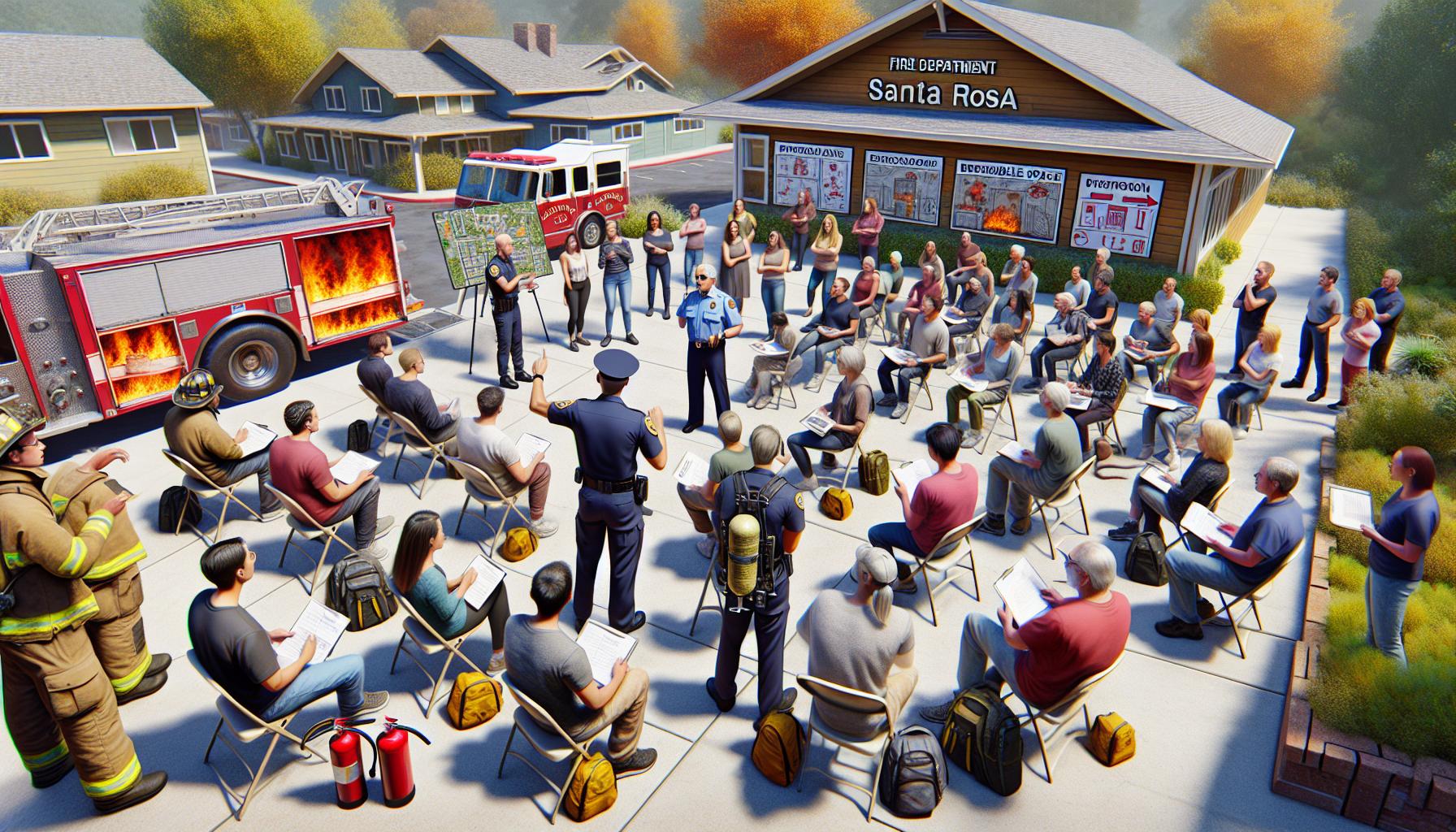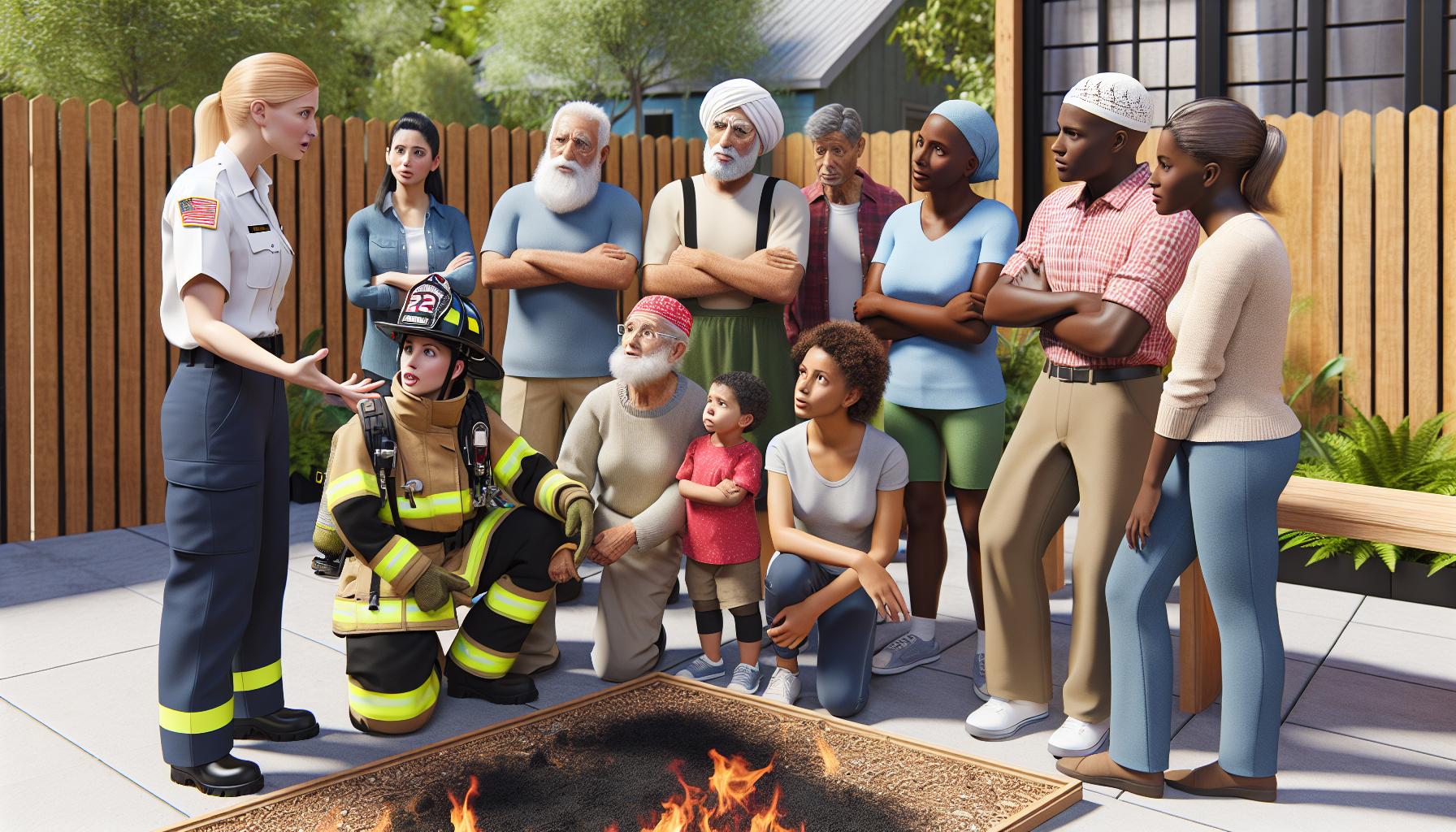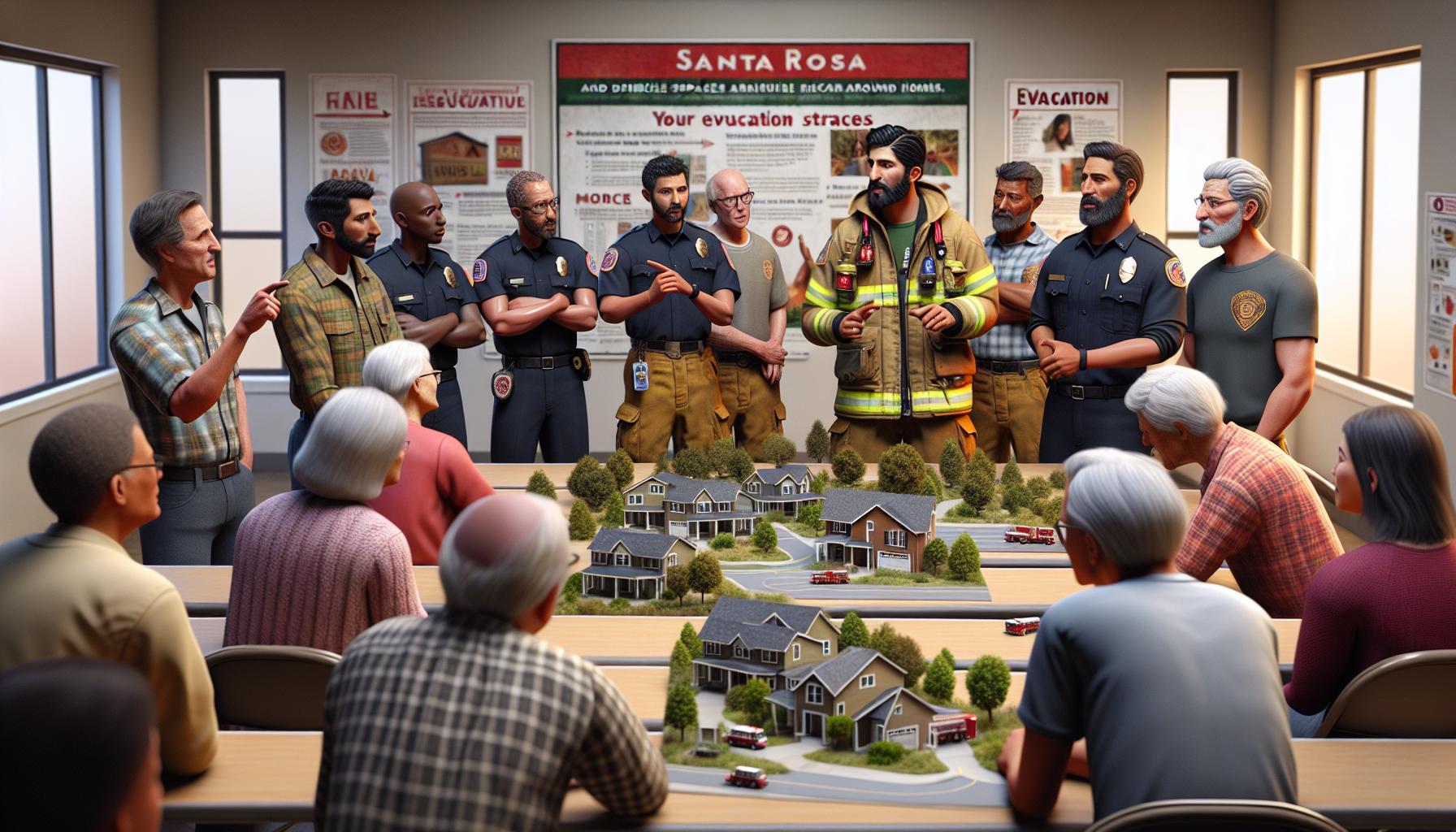When I first heard about the Santa Rosa fire department’s safety workshops, I was intrigued. Living in a region where wildfires are a stark reality, understanding fire safety has always seemed like essential knowledge, not just for me but for my entire community. These workshops, organized by our local heroes, are not just informative sessions; they’re a beacon of hope and a testament to the community’s resilience.
I’ve always believed that being prepared is half the battle won. That’s why I decided to dive deeper into what these workshops offer and how they’re making a difference in our community’s approach to fire safety. From practical demonstrations to engaging discussions, it’s clear that these workshops are designed to empower us with the knowledge and skills to protect ourselves, our loved ones, and our homes from the threat of fires. Join me as I explore the heart of these workshops and share why they’re a must-attend for every Santa Rosa resident.
Overview of Santa Rosa Fire Department Safety Workshops
Building on the foundation of resilience and preparedness in a wildfire-prone region, the Santa Rosa Fire Department’s safety workshops stand out as a crucial initiative for empowering the community. These workshops, designed with the local climate and environmental challenges in mind, aim to equip Santa Rosa residents with the tools and knowledge they need to effectively respond to fire emergencies. Here, I’ll dive into the structure, content, and objectives of these workshops to help you understand why attending them could be a significant step towards enhancing your safety and preparedness.
First, the structure of these workshops is both comprehensive and engaging. They are typically divided into several segments, each focusing on different aspects of fire safety, including but not limited to preventative measures, evacuation strategies, and emergency response techniques. This structured approach ensures that attendees leave with a holistic understanding of fire safety.
In terms of content, the workshops cover a wide range of topics that are both relevant and practical. For instance, you’ll learn about creating defensible spaces around your home, a critical step in mitigating the risk of wildfires. Instructors also discuss the importance of having an evacuation plan, covering how to prepare one that considers the needs of every family member, including pets. Moreover, practical demonstrations of how to use fire extinguishers and other firefighting tools are often part of the curriculum, providing hands-on experience that can be invaluable in an emergency.
Objectives of the Santa Rosa Fire Department safety workshops are clear – to reduce the risk of fire-related incidents and to ensure that residents have the skills and knowledge to protect themselves during such events. Through engaging discussions and practical demonstrations, these workshops aim to instill a sense of preparedness and resilience among attendees. The ultimate goal is to foster a community that is not only well-educated about fire safety but also confident in its ability to respond effectively to fire emergencies.
Attending these workshops offers a unique opportunity to learn from experienced fire safety professionals about how to safeguard your home and loved ones against fires. Given the increasing frequency and severity of wildfires in the region, there’s never been a more critical time to prioritize fire safety education. I urge all Santa Rosa residents to take advantage of these invaluable workshops. Doing so not only enhances your personal safety but also contributes to the broader safety and resilience of the entire community.
Key Focus Areas of the Workshops

Building on the vital foundation laid out earlier regarding the Santa Rosa Fire Department’s safety workshops, I’ll delve into the key focus areas designed to bolster community preparedness and resilience against wildfires. These workshops, crucial in a region perennially threatened by wildfires, hone in on several pivotal themes, each tailored to equip and empower residents.
Creating Defensible Space
Firstly, a significant portion of the workshops concentrates on creating defensible spaces around properties. Participants learn the importance of maintaining a buffer zone between their homes and the potential fuel provided by wild grasses, trees, bushes, and other flammable materials. The instructors guide attendees on the strategic removal or reduction of these elements to slow the fire’s spread, significantly mitigating potential damage.
Evacuation Strategies
Another core area focuses on evacuation strategies. Given the unpredictable nature of wildfires, having a clear, practiced evacuation plan is crucial. Workshop leaders emphasize the importance of knowing multiple exit routes from one’s neighborhood, making timely decisions to evacuate, and maintaining a go-bag with essential documents, medications, and supplies. Understanding these strategies can be the difference between safety and peril in emergency situations.
Emergency Response Techniques
Additionally, the workshops dive into emergency response techniques. I discover how to properly use firefighting tools like fire extinguishers and hoses, alongside basic firefighting tactics that can be employed safely by residents until professional help arrives. This section is designed not just to educate but to provide hands-on experience, reinforcing the knowledge through practical application.
Communication Strategies
Communication strategies also stand out as a key focus. Effective communication, both with family members and emergency services, is pivotal during a fire incident. Workshop participants learn how to establish and use communication plans that include meeting points, contact lists, and the use of technology to stay informed and connected during wildfires.
First Aid Basics
Lastly, the workshops cover first aid basics, essential for treating minor injuries that might occur during a wildfire. Understanding basic first aid techniques such as treating burns, smoke inhalation symptoms, and cuts ensures participants are better prepared to help themselves and others in a time of need.
The Role of Firefighters in Community Safety Education

Building on the foundation laid by the Santa Rosa Fire Department’s safety workshops, I find it vital to spotlight the crucial role firefighters play in community safety education. These workshops, emphasizing wildfire preparedness, also serve as a testament to how firefighters extend their duty beyond the frontline of fire suppression.
Firefighters, in my experience, are not just responders; they’re educators, mentors, and community leaders. They possess a unique blend of practical skills and knowledge, making them invaluable resources for teaching the public about fire safety. Through these workshops, they impart lifesaving strategies and foster a culture of safety and resilience within the community.
Firstly, my interactions have shown me that firefighters take a hands-on approach to teaching. They provide demonstrations on creating defensible spaces, showcasing techniques to maintain buffer zones that can slow or stop the spread of wildfires. This practical advice is crucial in a region like Santa Rosa, where wildfires pose a significant threat.
Secondly, firefighters lead by example, illustrating effective evacuation strategies during these workshops. They role-play scenarios that allow participants to practice what they’ve learned in a controlled but realistic environment. This experiential learning approach ensures that residents don’t just understand the steps to take but can execute them under pressure.
Moreover, firefighters share their experiences and insights on emergency response techniques. They cover the use of firefighting tools, reinforcing the importance of proper equipment and how to utilize it safely and efficiently. This knowledge empowers residents to protect their homes and neighborhoods until professional help arrives.
Communication strategies form another essential component of their educational role. Firefighters emphasize the importance of having clear, predetermined communication plans during emergencies. They guide residents in establishing these plans, ensuring that everyone knows how to stay informed and connected when disaster strikes.
Lastly, firefighters provide basic first aid training, a critical skill in any emergency. They teach techniques for treating burns, smoke inhalation, and other fire-related injuries. This training reinforces the importance of immediate and appropriate medical response, potentially saving lives even before medical professionals can reach the scene.
As I’ve observed, the firefighters of the Santa Rosa Fire Department are pillars of safety education within the community. Their dedication to teaching, coupled with their expertise, strengthens the community’s preparedness and resilience against wildfires. Through these safety workshops, they not only share critical knowledge but also inspire a collective commitment to safety and preparedness among residents.
Benefits of Attending Safety Workshops

Attending safety workshops, especially those hosted by the Santa Rosa Fire Department, offers numerous advantages that go beyond basic fire safety. These sessions equip participants with critical knowledge and skills, fostering a deep understanding of how to protect themselves, their families, and their properties from wildfires and other emergencies. Here, I’ll delve into some of the key benefits these workshops provide.
Enhanced Preparedness
The hands-on training and comprehensive education received at these workshops significantly improve attendees’ preparedness for wildfires. By understanding how to create defensible spaces and implement effective evacuation strategies, residents can significantly reduce their risk in the event of a fire. This enhanced preparedness ensures individuals feel more confident in their ability to protect their homes and loved ones.
Increased Awareness
Participants gain increased awareness about the importance of emergency response and communication plans. The workshops highlight the critical nature of having a clear, practiced plan in place, making it easier for families and communities to stay safe during crises. This awareness is vital, as it encourages a proactive approach to fire safety and emergency preparedness.
Practical Skill Development
Through practical exercises, attendees develop invaluable skills such as basic first aid, defensible space creation, and safe evacuation methods. These skills are not only essential during wildfires but are also beneficial in various emergency situations. The ability to administer first aid, for instance, can save lives in accidents or health emergencies, making this training invaluable.
Community Resilience
By fostering a culture of preparedness, the Santa Rosa Fire Department’s safety workshops contribute to building a more resilient community. As individuals and families become better prepared, the collective ability of the community to withstand and recover from disasters improves. This enhanced resilience is crucial for minimizing the impact of wildfires and other emergencies on our community.
Access to Expertise
Finally, these workshops provide direct access to the expertise of firefighters and emergency responders. Their firsthand experience and knowledge are unparalleled, offering attendees the chance to learn from those who face wildfires and other emergencies on the front lines. This access allows for a deeper understanding of fire dynamics, safety protocols, and emergency responses, enriching the overall learning experience.
How to Participate in the Workshops
Participating in the Santa Rosa Fire Department’s safety workshops is a seamless process designed to ensure everyone in the community can learn essential safety skills. From signing up to attending these informational sessions, I’ve outlined the steps you’ll need to take to be a part of this critical endeavor.
Find Workshop Schedules and Topics
First, keep an eye on the Santa Rosa Fire Department’s official website or their social media pages. They regularly post updates about upcoming workshops, including details on the topics covered, such as wildfire preparedness, creating defensible spaces, and evacuation strategies. Newsletters from the city or community boards often feature these workshops as well.
Register for the Workshops
Once you’ve found a workshop or series of workshops that interest you, the next step is registration. The Santa Rosa Fire Department generally offers an online registration form that’s easy to fill out. Make sure to include all requested information to secure your spot. For workshops requiring no registration, I still recommend marking the event in your calendar and arriving early to get a good seat.
Prepare for the Workshop
Before attending, I suggest reading up on the topic of the workshop. The more you know going in, the more you’ll gain from the experience. Consider preparing a list of questions you have. This proactive approach enhances the learning process and allows you to engage more deeply with the material and the experts presenting it.
Attend and Engage
On the day of the workshop, make sure to arrive on time and with any materials that were recommended or required. Engagement is key during these sessions. Don’t hesitate to ask questions or participate in discussions. Active participation not only enriches your learning experience but also supports a dynamic and interactive environment for all attendees.
Follow Up
After the workshop, take the initiative to review the materials provided and implement what you’ve learned. If the workshop inspired further questions, don’t hesitate to reach out to the Santa Rosa Fire Department for more information. They’re usually more than happy to provide additional resources or guidance to individuals eager to enhance their safety knowledge.
By taking these steps to participate in the Santa Rosa Fire Department’s safety workshops, you’re not only gaining valuable knowledge and skills but also contributing to the overall resilience and safety of your community. Whether it’s wildfire preparedness, evacuation strategies, or learning about defensible spaces, these workshops offer a unique opportunity to learn directly from the experts.
Feedback and Impact
Reflecting on the Santa Rosa Fire Department’s safety workshops, the feedback from participants and the consequent impact on the community are both impressive and heartening. My conversations with numerous attendees have revealed a deep sense of gratitude and empowerment that stands testament to the workshops’ effectiveness. Individuals express feeling more prepared and less fearful about the potential of wildfires, which, in the context of Santa Rosa’s history with fires, is a significant shift in community sentiment.
Participants particularly praise the hands-on experience and the clarity of the instructions provided on creating defensible spaces around their homes. The detailed evacuation strategies, complemented by interactive sessions on emergency response and communication plans, have equipped families with actionable plans, reducing panic and enhancing their confidence in facing emergencies. Moreover, the first aid basics, though a small segment of the workshops, have been highlighted as a crucial skill set that attendees feel fortunate to have learned.
The impact of these workshops extends beyond individual preparedness. A notable increase in community engagement activities, such as neighborhood safety drills and the formation of local emergency response teams, underscores a broader cultural shift towards proactive disaster readiness. Feedback indicates that these workshops have sparked conversations among neighbors, with more residents sharing information and resources on fire safety, thereby strengthening community bonds and resilience.
Schools in Santa Rosa have reported a heightened interest among students in fire safety and prevention, following their parents’ participation in the workshops. This has led to the introduction of more comprehensive fire safety education in school curricula, amplifying the workshops’ reach and impact.
From an emergency responder’s perspective, the workshops have fostered a stronger relationship between the Santa Rosa Fire Department and the community. The direct interaction during these sessions has demystified the roles of firefighters, making them more approachable and further integrating them into the community fabric. This dynamic is critical for efficient emergency response, as trust and familiarity can significantly ease communication and cooperation during actual fire incidents.
Overall, the feedback from these safety workshops and their tangible impact offer a beacon of hope for not just Santa Rosa, but for communities everywhere. By taking proactive steps towards wildfire preparedness and cultivating a culture of safety and awareness, we can collectively enhance our resilience against disasters. Witnessing this transformation first-hand, I am optimistic about the continued success of these initiatives and their role in building a safer, more prepared community.
Conclusion
I’ve seen firsthand the transformative power of the Santa Rosa Fire Department’s safety workshops. It’s clear they’re more than just educational sessions; they’re a beacon of hope for a community striving for resilience and safety. The feedback speaks volumes about the impact of these workshops. They’ve not only equipped individuals with the knowledge to protect themselves and their loved ones but also fostered a sense of unity and cooperation that’s crucial in times of crisis. It’s inspiring to see such a positive shift towards proactive disaster readiness. These workshops are a testament to the power of community and education in building a safer world for all of us.
Ben Rutstein is the publisher of this website, he started traveling to northern California in 2014, and the Santa Rosa is one of his favorite places to visit, from that time onwards he has explored everything from visiting cafes to yoga in parks, local hikes.
He is known to drop everything at a moments notice for a visit to a winery or a visit to a park.
